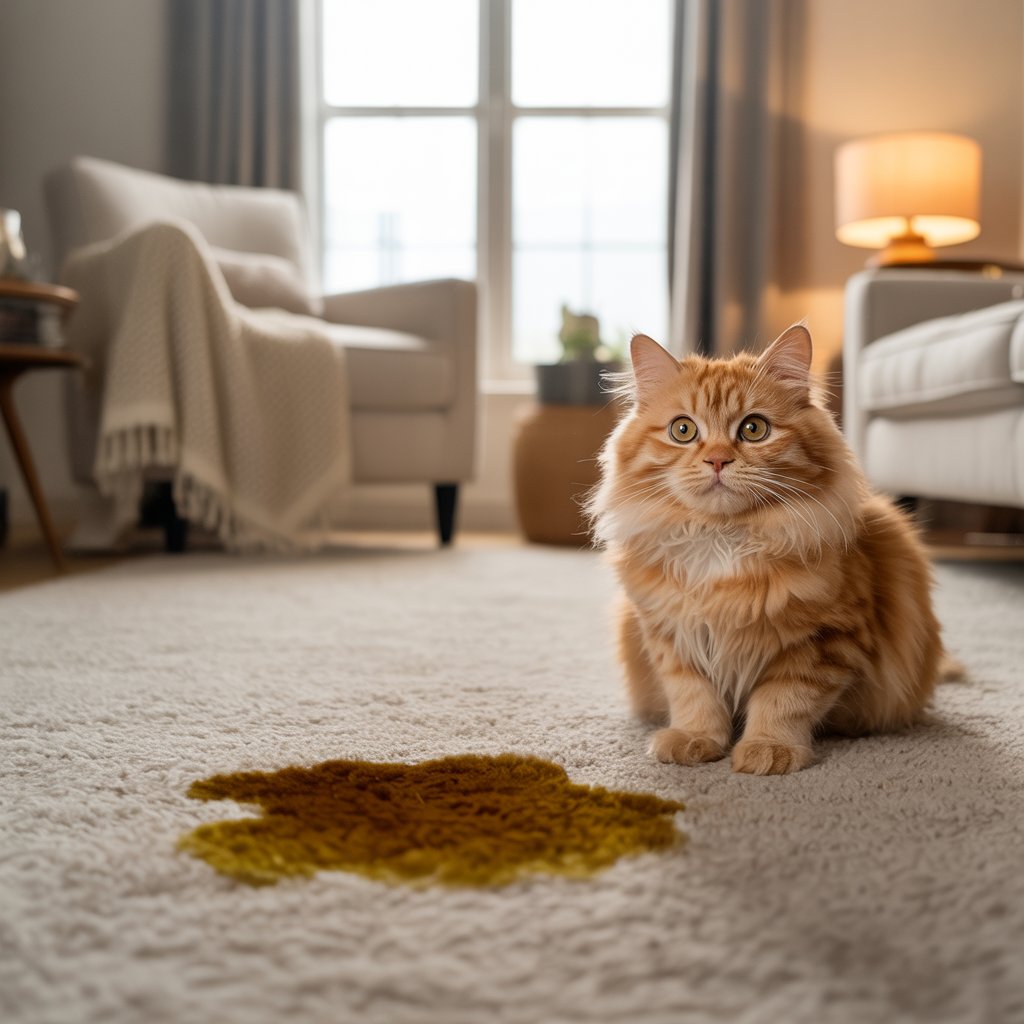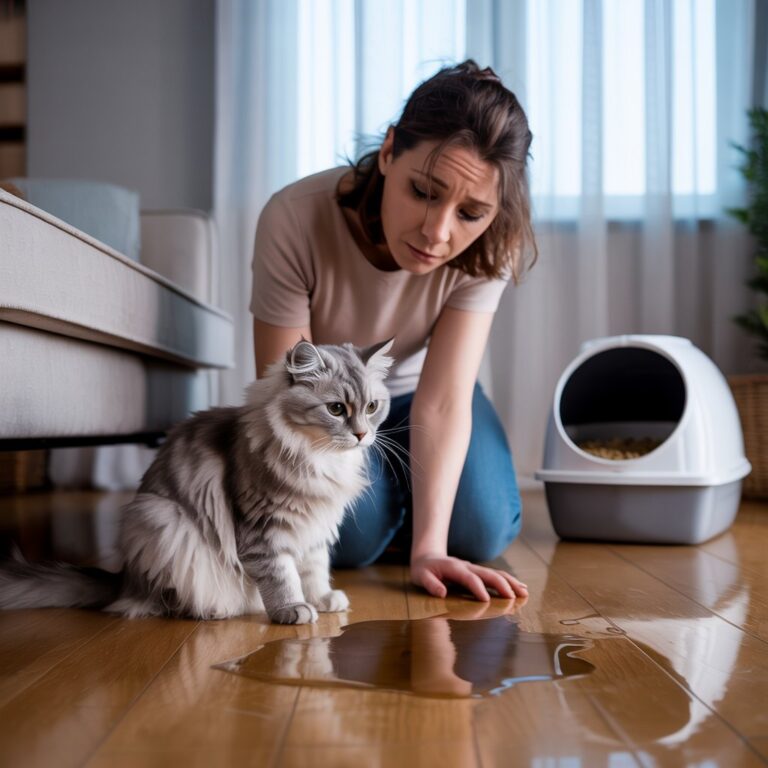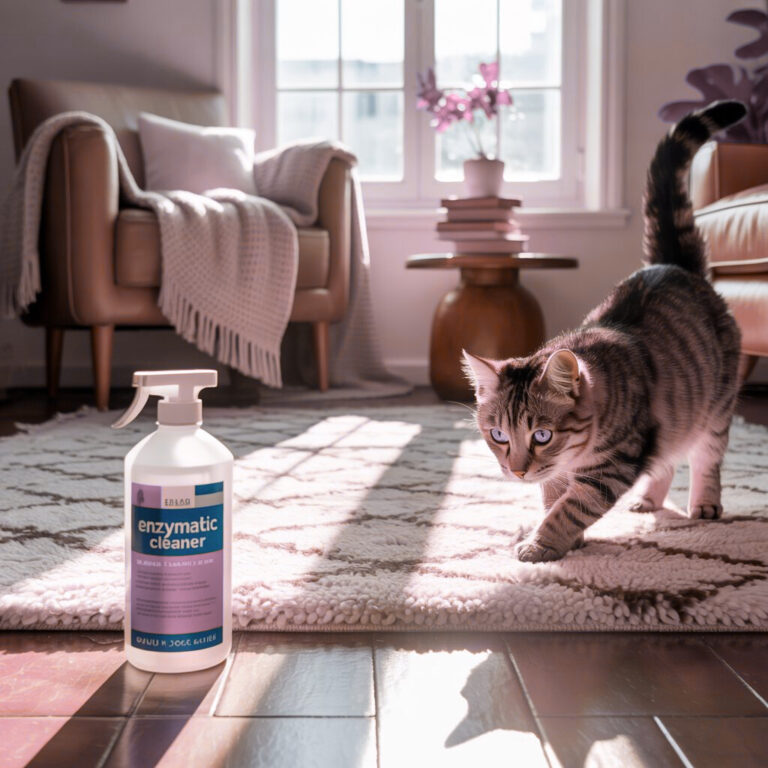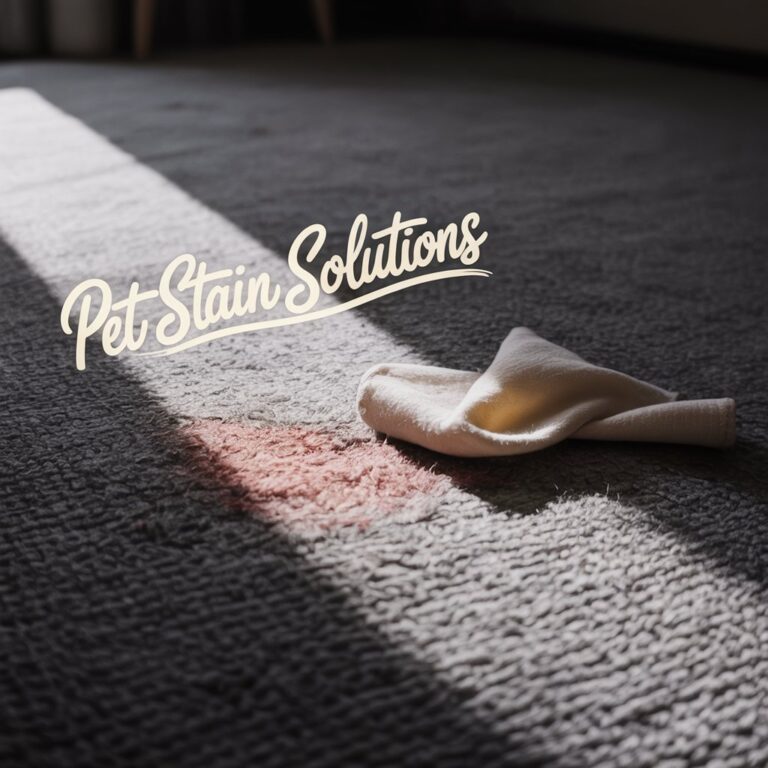Remove Cat Pee For Good: What Really Works
Learn why cat urine odor persists—and how to identify and remove cat pee from your home effectively.
If you’ve ever cleaned a spot of cat pee only to have the smell creep back days—or even weeks—later, you’re not imagining things. Cat urine has a way of lingering, and it’s not just annoying—it’s downright stubborn. But there’s a very good reason for that.
Let’s break it down and talk about how to actually get rid of smell of cat pee.
Contents
Why It’s So Hard to Remove Cat Pee Smells
Cat urine contains uric acid crystals, and they’re the real reason behind that pungent, ammonia-like smell that just won’t quit. These crystals are insoluble in water. Meaning they don’t simply wash away with soap or water, they can last for years—and most common household cleaners can’t touch them.
You might wipe the area, spray something fragrant over it, and think the job is done. But give it a little humidity or warmth, and that odor will come right back to remind you it’s still there.
Common Cleaning Mistakes That
Don’t Remove Cat Pee
- Using vinegar or baking soda: These might neutralize odor temporarily, but they won’t break down uric acid crystals.
- Masking with scent sprays or air fresheners: These only cover the smell—never fix the source.
- Skipping a second treatment: One round of cleaning might not be enough, especially if the urine soaked into soft surfaces or under floorboards.
At a Glance: Cat Pee Cleaning Solutions
| Topic | Details |
| Cat urine contains | Urea, uric acid, creatinine, ammonia, salts, and pheromones. |
| Why cat urine smells bad | Bacteria break down urea, releasing ammonia and foul-smelling compounds. |
| Why the smell gets worse over time | Uric acid dries and forms crystals that reactivate with moisture. |
| Male cats that aren’t neutered | Have stronger-smelling urine due to high hormone levels. |
| Products that can help remove cat pee | Enzyme-based cleaners, live bacteria cleaners, oxidizing agents like sodium percarbonate. |
| Products to avoid | Ammonia, vinegar, bleach — these can worsen the smell or attract re-marking. |
| Steps to clean fresh cat pee | Blot with clean cloth, apply enzymatic cleaner, let sit, blot again, allow to air dry. |
| Steps for old or smelly stains | Pre-treat with sodium percarbonate, then apply live bacteria cleaner and keep damp for 6–24 hrs. |
| Why a stain might still smell | Uric acid crystals remain if not broken down by uricase-producing bacteria (bio-enzymatic cleaners). |
| Why cats pee outside the litter box | Health issues (UTIs, kidney disease) or behavioral issues (stress, territory, dirty litter box). |
| How to prevent cat urine smell | Scoop litter daily, clean weekly, reduce stress, and keep it in a low traffic area. |
How to Identify Where the Cat Pee Smell Is Coming From
Even if you can’t see it, your cat can still smell it—and might keep returning to the same spot.
Try this:
- Use a UV flashlight: Cat urine glows under blacklight, making it much easier to pinpoint problem areas.
- Get nose-level: It sounds weird, but sometimes the only way to locate the exact spot is by trusting your nose (and your gut).
- Watch your cat: If they keep sniffing or avoiding a certain spot, they’re telling you something’s still off.
What Actually Works to Remove Cat Pee
Cat pee isn’t like other messes. You can’t just wipe it up and expect the smell to disappear—especially if it’s been sitting for a while. That’s because cat urine contains uric acid crystals, which are like tiny chemical leftovers that don’t dissolve in water. If you don’t break those down, the smell will come back.
Here’s what to do, depending on how fresh the pee is.
🟢 For Fresh Cat Pee (Less Than 1 Hour Old)
If you catch it early, you’re in luck! You can stop the odor before it settles in.
Step 1: Blot, don’t scrub
Use paper towels or a clean cloth to soak up as much of the urine as possible. Press firmly, and try not to rub—it can push the urine deeper into carpet or fabric.
Step 2: Apply an enzymatic cleaner
These cleaners use natural enzymes that eat away the bacteria in cat urine that causes long-term smells. Look for one made specifically for cat urine, not just “pet odors.”
Step 3: Let it sit
Don’t rush this part—enzymatic cleaners need time to work. Let it sit for at least 10–15 minutes, or longer if the product says so.
Step 4: Blot again and air dry
After the cleaner does its job, blot up the extra liquid and let the area dry naturally. Don’t cover it or use a fan just yet—air drying helps the enzymes finish their work.
Some products that work:
🧴 Top Enzymatic Cleaners for Fresh Cat Pee
| Product Name | Enzyme Type | Best For | Surface Compatibility | Notes |
|---|---|---|---|---|
| Rocco & Roxie Stain & Odor Eliminator | Bacteria-based enzymes | Fresh pee on carpets & fabrics | Carpet, upholstery, hard floors | Popular, highly rated; must keep damp for hours |
| Simple Solution Cat Stain & Odor Remover | Enzymatic + oxidizing boosters | Multi-pet homes | Fabric, carpet, wood, tiles | Fast-acting; gentle scent |
| Nature’s Miracle Cat Urine Remover | Bio-enzymatic formula | Quick household cleanup | Most household surfaces | Widely available; reliable brand |
| Bubba’s Rowdy Friends Pet Stain Terminator | Commercial-strength enzymes | Tougher stains & large spots | Carpet, rugs, car interiors | Professional grade, effective when left to dwell |
🔴 For Old Cat Pee Stains (Over an Hour Old or Already Dried)
Old urine is tougher because the uric acid crystals have had time to dry and settle deep into soft surfaces like carpet padding or fabric. Here’s how to tackle it:
Step 1: Reactivate the stain
Lightly dampen the area with warm water to “wake up” the dried urine so your cleaner can reach it.
Step 2: Use an oxygen-based cleaner (optional but worth it if you want to completely remove cat pee)
Old cat urine has usually dried into the surface and bonded tightly.
Oxygen-based cleaners bubble and fizz as they release oxygen gas (from hydrogen peroxide), which physically agitates and lifts:
- Dried urea and proteins
- Urine salts
- Yellowish stains
This opens up the surface and makes the uric acid crystals more accessible for follow-up treatments. So, if the stain is very old, you can use a small amount of an oxygen-based cleaner (like sodium percarbonate, found in some laundry soakers like Vanish or Nappy San) to help lift the stain. Let it sit for a few minutes, then blot.
⚠️ Don’t use this step on wool or delicate fabrics. Always test a hidden spot first.
Step 3: Apply a bio-enymatic cleaner
You need something that breaks down the uric acid crystals completely. Choose:
- A high-quality enzymatic cleaner, that that includes a live bacteria-based formula (these are like tiny helpful microbes that “eat” the uric acid crystals)
Step 4: Let it soak—longer this time
Older stains may need the cleaner to sit for several hours (or even overnight) before you blot and let it dry. After applying a bio-enzymatic cleaner, it’s important to keep the stain damp and covered so the live bacteria have time to work. These bacteria need moisture to stay active while they break down the uric acid, proteins, and odor-causing compounds in the urine.
The best way to cover a pee stain after applying the bio-enzymatic solution, is by covering the area with a clean, damp towel or plastic wrap for 12–24 hours, checking occasionally to ensure it hasn’t dried out too soon.
🧴 Top Cleaners for Old Cat Pee Stains
| Product Name | Type | Best For | Surface Compatibility | Notes |
|---|---|---|---|---|
| ODOBAN Pet Odor Neutralizer & Enzyme Cleaner | Bio-enzymatic | Breaking down old protein & urine residues | Carpets, upholstery, hard surfaces | Strong enzymatic blend; budget-friendly |
| Anti-Icky-Poo Unscented | Live bacteria (uricase-producing) | Digesting uric acid & odor | Carpets, floors, grout | Works well after oxidizer pretreatment |
| Vanish Napisan / Nappy San (Oxi Action) | Sodium percarbonate (oxidizer) | Lifting old uric acid crystals | Carpets, rugs, washable surfaces | Needs to be rinsed out; pre-treat before enzyme |
| Bubba’s Pet Stain & Odor Remover | Bio-enzymatic | Removing lingering odor & bacteria | Most soft surfaces | Works well as second step after Oxi clean |
| Simple Solution Oxy Formula | Enzyme + oxidizer blend | Treating set-in stains with odor | Soft furnishings, floors | Combines both enzyme and oxygen action |
Step 5: Be patient
It might take more than one treatment. That’s normal. The smell will often fade more after 24–48 hours as the cleaner finishes breaking down the odor source.
Frequently Asked Questions (FAQs)
1. Why does cat pee smell so strong?
Cat urine contains uric acid, urea, ammonia, and other waste compounds. When left untreated, uric acid forms crystals that bond to surfaces and release odor repeatedly — especially when exposed to moisture or humidity.
2. Why is it so hard to remove cat pee smell completely?
Because most cleaners only tackle surface-level mess. Uric acid crystals stay behind, and standard disinfectants or sprays don’t break them down. The smell returns over time unless the right products are used.
3. What’s the best way to remove cat pee from carpet?
For fresh stains (less than an hour old), blot it up and use an enzymatic cleaner.
For older stains, start with an oxidizer (like sodium percarbonate) to lift embedded crystals, then follow up with a live bacteria-based cleaner to digest any remaining uric acid, proteins, and odor-causing bacteria.
4. Can I just use vinegar or baking soda to remove cat pee?
Not really. Vinegar and baking soda can mask the odor temporarily, but they don’t break down uric acid crystals — so the smell often returns. For a permanent fix, you’ll need a cleaner that targets the actual cause.
5. Do I need a blacklight to find old cat pee stains?
It’s highly recommended. Cat urine glows under a UV blacklight, helping you find dried stains you might otherwise miss. Once you locate them, you can properly treat each spot using the right method.
6. Are enzyme cleaners enough on their own?
For fresh accidents, yes — they can usually handle the mess before crystals form. But for older or repeated stains, enzyme cleaners alone may not be enough. You’ll likely need an oxidizing booster or live bacteria that produce uricase to fully break down the uric acid.
7. Can I use bleach to remove cat pee smell?
No — bleach doesn’t break down uric acid, and combining it with ammonia in cat urine can actually release dangerous fumes. Stick to pet-safe, purpose-formulated cleaners.
Recommended Reading
Cats Peeing or Pooping Outside The Litterbox? You’re Setting Up Your Litterbox All Wrong



